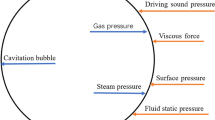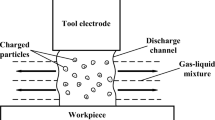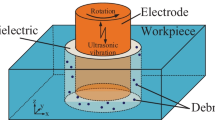Abstract
Ultrasonic vibration-assisted micro-EDM can improve the machinability of difficult to machine materials such as titanium alloy and superalloy. To explore the influence mechanism of ultrasonic vibration on material erosion in micro-EDM, a heat-flow coupling model was proposed. In the study, the effects of ultrasonic vibration, including workpiece vibration and electrode circular vibration, on the formation of discharge craters, were explained based on the theories of heat transfer and hydrodynamics. The simulation results showed that the material is mainly removed by evaporation at the initial stage of discharge, and then the molten material splashes away from the workpiece through the edge of the discharge crater, while the molten material not separated from the workpiece cools and solidifies around the discharge crater to form a bulge. The workpiece vibration is conducive to strengthening the splashing of molten liquid, so as to form larger and deeper discharge craters. The electrode circular vibration can cause the discharge spot to slip on the surface of the workpiece, forming discharge craters with larger area and shallower depth. The morphologies of the discharge craters obtained by single-pulse discharge experiments were in good agreement with the simulated craters. The results of square cavity machining experiment indicated that the machining efficiency under workpiece vibration and electrode circular vibration assistance were improved by 24.3% and 23.0%, respectively. The material removal depth under workpiece vibration is larger, while the material removal depth under electrode circular vibration is smaller, but electrode circular vibration is conducive to reducing the roughness of machined surface. The results of single-pulse discharge experiments and square cavity machining experiments were in good agreement with the simulation results, which indicates that the proposed simulation model is suitable to explain the influence of ultrasonic vibration on micro-EDM.














Similar content being viewed by others
References
Ho KH, Newman ST (2003) State of the art electrical discharge machining (EDM). Int J Mach Tools Manuf 43(13):1287–1300. https://doi.org/10.1016/S0890-6955(03)00162-7
Mohd Abbas N, Solomon DG, Fuad Bahari M (2007) A review on current research trends in electrical discharge machining (EDM). Int J Mach Tools Manuf 47(7–8):1214–1228. https://doi.org/10.1016/j.ijmachtools.2006.08.026
Ezugwu EO, Wang ZM (1997) Titanium alloys and their machinability—a review. J Mater Process Technol 68(3):262–274. https://doi.org/10.1016/S0924-0136(96)00030-1
Wang F, Liu Y, Zhang Y, Tang Z, Ji R, Zheng C (2014) Compound machining of titanium alloy by super high speed EDM milling and arc machining. J Mater Process Technol 214(3):531–538. https://doi.org/10.1016/j.jmatprotec.2013.10.015
Klocke F, Schwade M, Klink A, Kopp A (2011) EDM machining capabilities of magnesium (Mg) alloy WE43 for medical applications. Procedia Engineering 19:190–195. https://doi.org/10.1016/j.proeng.2011.11.100
Hou S, Bai J (2021) A geometric prediction model of surface morphology in micro-EDM considering stochastic characteristics of discharge crater size. The Int J Advanced Manuf Technol 117(3–4):1147–1162. https://doi.org/10.1007/s00170-021-07795-9
Han F, Wang Y, Zhou M (2009) High-speed EDM milling with moving electric arcs. Int J Mach Tools Manuf 49(1):20–24. https://doi.org/10.1016/j.ijmachtools.2008.08.005
Luo YF (1997) The dependence of interspace discharge transitivity upon the gap debris in precision electrodischarge machining. J Mater Process Technol 68(2):121–131. https://doi.org/10.1016/S0924-0136(96)00019-2
Kremer D, Lhiaubet C, Moisan A (1991) A study of the effect of synchronizing ultrasonic vibrations with pulses in EDM. CIRP Ann 40(1):211–214. https://doi.org/10.1016/S0007-8506(07)61970-2
Lin YC, Yan BH, Chang YS (2000) Machining characteristics of titanium alloy (Ti–6Al–4V) using a combination process of EDM with USM. J Mater Process Technol 104(3):171–177. https://doi.org/10.1016/s0924-0136(00)00539-2
Shabgard MR, Alenabi H (2015) Ultrasonic assisted electrical discharge machining of Ti–6Al–4V alloy. Mater Manuf Processes 30(8):991–1000. https://doi.org/10.1080/10426914.2015.1004686
Hung J-C, Lin J-K, Yan B-H, Liu H-S, Ho P-H (2006) Using a helical micro-tool in micro-EDM combined with ultrasonic vibration for micro-hole machining. J Micromech Microeng 16(12):2705–2713. https://doi.org/10.1088/0960-1317/16/12/025
Zhang QH, Du R, Zhang JH, Zhang QB (2006) An investigation of ultrasonic-assisted electrical discharge machining in gas. Int J Mach Tools Manuf 46(12–13):1582–1588. https://doi.org/10.1016/j.ijmachtools.2005.09.023
Li Z, Tang J, Li Y, Bai J (2022) Investigation on surface integrity in novel micro-EDM with two-dimensional ultrasonic circular vibration (UCV) electrode. J Manuf Process 76:828–840. https://doi.org/10.1016/j.jmapro.2022.03.004
Jahan MP, Wong YS, Rahman M (2012) Evaluation of the effectiveness of low frequency workpiece vibration in deep-hole micro-EDM drilling of tungsten carbide. J Manuf Process 14(3):343–359. https://doi.org/10.1016/j.jmapro.2012.07.001
Dong Y, Liu J, Li G, Wang Y (2022) Thermodynamic simulation modeling analysis and experimental research of vertical ultrasonic vibration assisted EDM. The Int J Advanced Manuf Technol 119(7–8):5303–5314. https://doi.org/10.1007/s00170-021-08604-z
Wang Y, Liu Z, Shi J, Dong Y, Yang S, Zhang X, Lin B (2020) Analysis of material removal and surface generation mechanism of ultrasonic vibration–assisted EDM. The Int J Advanced Manuf Technol 110(1–2):177–189. https://doi.org/10.1007/s00170-020-05769-x
Choubey M, Maity KP, Sharma A (2020) Finite element modeling of material removal rate in micro-EDM process with and without ultrasonic vibration. Grey Systems: Theory and Application 10(3):311–319. https://doi.org/10.1108/GS-11-2019-0047
Wang, L., Wang, H., & Cheng, T. (2022). Design and performance of a compact stick-slip type piezoelectric actuator based on right triangle flexible stator. Smart Materials and Structures, 31(5). https://doi.org/10.1088/1361-665X/ac6206.
Song CL, Tao Y, Liu WY, Chen YC, Xue R, Jiang TY, Li B, Jiang HY, Ren YK (2022) Fluid pumping by liquid metal droplet utilizing ac electric field. Phys Rev E 105(2–2):025102. https://doi.org/10.1103/PhysRevE.105.025102
Courtois, M., Carin, M., Le Masson, P., Gaied, S., & Balabane, M. (2014). A complete model of keyhole and melt pool dynamics to analyze instabilities and collapse during laser welding. Journal of Laser Applications, 26(4). https://doi.org/10.2351/1.4886835.
Sharma S, Mandal V, Ramakrishna SA, Ramkumar J (2018) Numerical simulation of melt hydrodynamics induced hole blockage in Quasi-CW fiber laser micro-drilling of TiAl6V4. J Mater Process Technol 262:131–148. https://doi.org/10.1016/j.jmatprotec.2018.06.038
Kojima A, Natsu W, Kunieda M (2008) Spectroscopic measurement of arc plasma diameter in EDM. CIRP Ann 57(1):203–207. https://doi.org/10.1016/j.cirp.2008.03.097
Akbari M, Saedodin S, Toghraie D, Shoja-Razavi R, Kowsari F (2014) Experimental and numerical investigation of temperature distribution and melt pool geometry during pulsed laser welding of Ti6Al4V alloy. Opt Laser Technol 59:52–59. https://doi.org/10.1016/j.optlastec.2013.12.009
Bonacina C, Comini G, Fasano A, Primicerio M (1973) Numerical solution of phase-change problems. Int J Heat Mass Transf 16(10):1825–1832. https://doi.org/10.1016/0017-9310(73)90202-0
Yue, X., & Yang, X. (2021). The role of discharge plasma on molten pool dynamics in EDM. Journal of Materials Processing Technology, 293. https://doi.org/10.1016/j.jmatprotec.2021.117092
Singh M, Sharma S, Ramkumar J (2020) Numerical simulation of melt-pool hydrodynamics in μ-EDM process. Procedia CIRP 95:226–231. https://doi.org/10.1016/j.procir.2020.02.289
Funding
This work was supported by the National Natural Science Foundation of China (No. 51575137), the Key Project of Natural Science Foundation of Heilongjiang Province of China (No. ZD2019E005), and the National Natural Science Foundation of China (No. 51975156).
Author information
Authors and Affiliations
Contributions
Shaojie Hou: conceptualization, methodology, writing—original draft preparation, investigation, data curation, visualization, editing. Jicheng Bai: supervision, project administration, funding acquisition, writing—review.
Corresponding author
Ethics declarations
Ethics approval
Not applicable.
Consent to participate
Not applicable.
Consent for publication
All authors have read and agreed to the published version of the manuscript.
Conflict of interest
The authors declare no competing interests.
Additional information
Publisher's note
Springer Nature remains neutral with regard to jurisdictional claims in published maps and institutional affiliations.
Rights and permissions
Springer Nature or its licensor (e.g. a society or other partner) holds exclusive rights to this article under a publishing agreement with the author(s) or other rightsholder(s); author self-archiving of the accepted manuscript version of this article is solely governed by the terms of such publishing agreement and applicable law.
About this article
Cite this article
Hou, S., Bai, J., Liu, H. et al. Study on material erosion mechanism of ultrasonic vibration-assisted micro-EDM based on heat-flow coupling analysis. Int J Adv Manuf Technol 125, 465–478 (2023). https://doi.org/10.1007/s00170-022-10695-1
Received:
Accepted:
Published:
Issue Date:
DOI: https://doi.org/10.1007/s00170-022-10695-1




